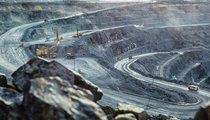A British start-up wants to restore lost Arctic ice with underwater drones!

The team of researchers and engineers from the University of Cambridge's Center for Climate Repair, in collaboration with the British startup Real Ice, are experimenting with an unprecedented solution to counter the loss of Arctic ice: using hydrogen-powered underwater drones to pump water from over the polar sea. ice cap, creating new layers of ice.
The purpose? Break the vicious cycle that accelerates ice melt and buy precious time to achieve the real goal: Reducing emissions and stabilizing the global climate.
For decades, the Arctic has been warming faster than the rest of the planet. As the sea ice melts, the sea surface absorbs more solar radiation, which in turn further accelerates the melting of the ice. It's a spiral (if you want, I'll go into more detail in the box at the end of this paragraph) that threatens to transform the Arctic and, with it, the entire world's climate. Today, some scientists are focusing on "unconventional" methods to slow this trend. Among them, a bold idea: recreating the thickness of the ice, using green technologies and underwater drones capable of spraying seawater on the surface, letting it refreeze.
How does it work?
The Arctic is warming at an astonishing rate, about four times faster than the global average. Since satellite measurements began in 1979, the amount of sea ice has declined dramatically. Melting polar ice not only raises sea levels, but also reduces Earth's ability to reflect sunlight back into space, increasing heat absorption and triggering a self-accelerating melting mechanism.

This dynamic, known as albedo feedback, could lead to completely ice-free Arctic summers by the middle of this century. The impacts would be huge: from climate destabilization to methane emissions from melting permafrost, to the risk of compromising entire ecosystems. Faced with this prospect, some researchers believe it is necessary to consider drastic action.
Real Ice's vision, as mentioned, is based on underwater drones powered by green hydrogen. These machines will be able to drill into the ice from below, then pump seawater up onto the ice shelf, creating an additional "ice blanket".
For Andrea Ceccolini, CEO of Real Ice, preliminary tests conducted over the past two years showed that the method can actually increase the thickness of ice. The principle is simple: if you can build thicker layers of ice, it becomes harder for them to melt completely in the summer. If the Arctic could retain ice year-round, the albedo effect would be restored, helping to curb global warming.

As fascinating as the idea is, growing it is far from simple. First, researchers must demonstrate that the process works not only in small experimental areas, but also in large regions. Second, logistical and financial problems arise: according to preliminary estimates, to achieve a significant effect at the level of the entire Arctic Ocean, investments of the order of 10 billion dollars per year may be needed.
In a recent test, Real Ice managed to create approximately 1,000 tons of new ice in an area the size of a football field. This is a promising result, but still far from the required scale. The ultimate goal, as mentioned, would be to prevent the ice from melting during the hottest summers, providing a permanent ice cover. Only more extensive tests, planned from 2024/2025, will be able to demonstrate whether the approach is truly capable of countering ice loss on a seasonal basis.
Real costs, benefits and opportunities
The figure of $10 billion a year is certainly impressive, but Ceccolini requires context: humanity has already spent much larger sums to tackle complex problems. Moreover, avoiding the worst impacts of climate change could save, in the long term, trillions of dollars in adaptation costs, environmental damage and economic damage.
The idea is that, if this technology proves effective, it would be a temporary bridge to buy time, allowing emissions to be reduced and CO2 concentrations to stabilize at stable levels (around 350 ppm).

It's an approach that fits into the wider debate on geoengineering, a term that often evokes distrust and fear. Some proposed methods, such as injecting aerosols into the stratosphere to reflect sunlight, are considered potentially dangerous and have unpredictable side effects. There is also the fear of so-called "moral hazard": If there are techniques to mitigate the symptoms of climate change, governments and industries may delay efforts to reduce emissions, knowing they have a "Plan B."
Ceccolini prefers to frame his proposal in "biomimicry," that is, an attempt to imitate or recreate existing natural processes. Before human-induced climate change, the Arctic was in equilibrium and the ice regenerated naturally. The idea of Real Ice, in this view, would simply be far from restoring a lost mechanism. Of course, maximum caution is required and the scientists themselves reiterate that this approach should not replace efforts to achieve net zero emissions, but integrate a broader strategy.

Biden miraton memorandumin e sigurisë kombëtare për të udhëhequr administratën Trump mbi kundërshtarët!
Presidenti Joe Biden ka miratuar një memorandum të klasifikuar të sigurisë kombëtare, i krijuar për të shërbyer si një udhërrëfyes për administratën e......

The ECB decides to cut interest rates again: What will happen next and why it matters!
The European Central Bank (ECB) is poised to cut its deposit rate by 25 basis points to 3% on Thursday, marking the third straight cut in borrowing costs as......

Komisioni propozon masa për të rritur ndikimin e fermerëve në zinxhirin e furnizimit ushqimor!
Ekzekutivi i BE-së zbuloi masat për të forcuar fuqinë negociuese të fermerëve përgjatë zinxhirit të furnizimit me ushqime, duke kërkuar të barazojë fuqinë......

The EU imposes new sanctions on Russia targeting the "shadow fleet" of oil tankers!
The European Union on Wednesday issued new sanctions against Russia, targeting the "shadow fleet" of tankers that Moscow has set up to circumvent Western......

Foreign direct investments increase slightly - BSH: 20% of them in the real estate sector
The value of foreign direct investments reached 412 million euros at the end of the third quarter, almost at the same level as the July-September period of......

"Villages, growing with agrotourism as an alternative" - Sokol Duma: To increase investments in the Alps without affecting the protected areas
The package of mountains is generating interest, especially among individuals who see this initiative as a new opportunity for development. This interest......

In 10 months, less energy was produced - Rain does not favor local generation. Less network loss
Energy production fell during the 10th month of this year, compared to the same period last year. According to data from the Energy Regulatory Agency, in......

The 2024 budget will be reviewed within the month - Malay: The fund for the spring bonus for retirees is determined
In April 2025, pensioners will receive another bonus from the government. In a press conference, the Minister of Finance, Petrit Malaj, emphasized that this......





















